#temples of longing
Explore tagged Tumblr posts
Text

June 8, 1897 Rilke and Andreas-Salomé: a love story in letters (1897-1926)
#rilke and andreas salome#rainer maria rilke#temples of longing#like ancient paths through wild forests#rilke was not of this earth#language of beauty#mellifluous#lou andreas salome#rilke#june#june 8#lou salome#literature#words#quotes#academia#dark academia#quote#lit#books#books and libraries#love#reading#love language#i love you#quote of the day#bookworm#book quotes#prose#booklr
315 notes
·
View notes
Text

DAY 2 - Alternative Universe (The Road To El Dorado AU!!)
#my art#one piece fanart#portgas d ace#revolutionary sabo#YEP YA HEARD THAT RIGHT 'THE ROAD TO EL DORADO AU' with Sabo and Ace as the main duo is something I wanted to draw#just two rascals with a dream of adventure :D#Now you are wondering If Tulio and Miguel is Sabo and Ace does that make Luffy Chel?#short answer yes but he plays kinda a different role#his the long dead brother who revived as a sun god#he is trapped in a temple with his followers guarding it from anyone that trys to enter due to his lack of freedom is very weak :(#All Sabo and Ace know is the prospect of something very valuable (treasure) and hunt down the sun god temple#but they return with a gift of fire and a person who look suspiciously like their dead little brother#the followers of the sun god mistaken Sabo and Ace as the sun gods and they play along hoping to find real treasure in the island#anyway I will definitely come back to this Au because it is so fun to imagine it#sabo week#sabo week 2025
791 notes
·
View notes
Text

The Temple of Time BOTW - Ink and Watercolor
Got a 97 on the assignment for my Creative Arts Media class and am putting it in our school’s art show, hope you guys enjoy what has been devouring my free time for the past 3 weeks!
#loz#the legend of zelda#botw#breath of the wild#temple of time#ocarina of time#legend of zelda#art#watercolor#pen and ink#2 point perspective#two point perspective#this took way too long#3 weeks#too long
1K notes
·
View notes
Text
If Durge Could Recruit Gortash Headcanons:
Once agreeing to ally with Gortash, Durge can convince him to join the party, but only if they agree to kill Raphael. If Karlach is in the party, this may be done in exchange for Gortash to fix her heart if Durge can pass the persuasion roll on Karlach.
• Upon joining the party, Gortash shows up in a more practical armor set, still gold and black but not as decorated as his robe. There’s scrapes and dents on parts of it, clearly having been worn before. Durge can ask him about it in conversation and discover he has chosen to wear the same armor as he did when they robbed Mephistopheles Vault. He never repaired it and can tell a story for each scratch.
• He does a lot to try to jog Durge’s memories, and it works a some degree. We hear little stories around the city, some more suggestive than others.
• Old habits never die. He’s constantly touching Durge, always walks next to them, has a lot of strong opinions but will only concede to Durge.
• Durge persuasion rolls on Gortash are DC10 and under. Anyone else it’s DC30.
• He absolutely compliments Durge a little too much. And he’s always the first at Durge’s side after the fighting ends. Grumbles if he has to rez anyone else but dotes on Durge.
• Gets along well enough with Astarion, Shadowheart, and Laezel. Respects Minthara and Gale, sees them both as potential allies if they know their places. Absolute bitch to Wyll. Actively the number one Ravengard hater.
• If Durge can convince Karlach to stick around, she will only be in the same party as Gortash once or twice. She’ll confront Durge about it after and either has to be kept separate or leaves the party.
• If taken to Astarion and Shadowhearts’ personal quests, he’ll be surprisingly respectful, and will tell them they’d make good Banites, particularly if Shadowheart resists Shar. (Kinda think he would tell Astarion not to Ascend but for his own advantage of not having to deal with an Ascended Vampire and not wanting the hells to gain power from 7,000 souls)
• Random gifts pop up in Durge’s inventory. He says nothing about them. One is definitely the hand of an enemy.
• When in the House of Hope, Gortash will only allow Durge to enter the prison with him until the warden is dead. He’ll tell them everything, but won’t let the others see it.
• Killing Raphael is very emotional. He’s proud, happy, relieved, but being there shakes him up. Durge can hug him in private when they talk about it.
• If Durge chooses to save Hope, she tries to hug ‘little Enver, all grown up�� before they leave. He does not like it, but part of him is happy to see her free.
• Durgetash romance can initiate after Raphael is dead. Sceleritas is so fuckin' pissed. Like, he kinda ships it, but he CANNOT handle Durge getting labotomized again for this Banite fool.
• He has random little personal quests and pop-up events like his formal coronation celebration ball, taking Durge to a fancy dinner, dealing with fans, and assassinating a rude journalist who called him not-so-young-and-handsome.
• If taken to Lady Jannath's estate, she flirts with him. Durge has an option to stab her for this- just once. Just a little. She'll be fine! Gortash approves. He apologizes to her, but he's absolutely into it.
• His two allied pathways at the end are to remain fully evil and control the brain/Faerun with Durge or absolutely still be, ya know, Gortash but destroy the brain and become archduke without the tadpoles' help as he’s now viewed as the city’s hero. This is his least evil option and requires a Durge romance or at least a Durge that will remain by his side regardless and saving Hope as pivotal moments.
• Durge's alliance or resistance of Bhaal would significantly influence this. Resisting Bhaal lowers the DC on any persuasion. Failing the duel with Orin would block any option except controlling the brain with Gortash as he sees it as the only way to protect Durge. Because controlling the absolute would offer them a large enough following to grant them literal ascension to godhood, freeing Durge from Bhaal's control. Plus, you know killing a god would only inflate Gortash's ego more, and that would be his new goal.
#This got so long but I have so many thoughts#bg3#baldurs gate 3#bg3 spoilers#durgetash#the dark urge#dark urge#durge#enver gortash#lord enver gortash#headcanon#cats thoughts#honestly think hed be down for most quests#but like for the sake of order rather than helping people#like if they let a hag ruin their life thats on them#but he cant have a hag in HIS city#Saverok and Orin would throw SUCH a fit if you brought him to the temple#it would be delicious
3K notes
·
View notes
Text
I had a debate with my coworker about the Jedi not being crib robbers, regardless of the outcome of our argument, it has got me feeling ill about the parents who gave their children to the Jedi before or even during the Clone Wars. I'm watching Rebels and Kanan sounds so sad when he says he didn't know his parents. And then replaying Survivor, Cal has a conversation with Mosey about parents, and I remember that Cal is from Coruscant.
Like, imagine you're a parent. You probably live in the more poverty stricken levels of Coruscant. It's only a few years before the Clone Wars, but there's no way you could know that. All you know is that you have a baby in your arms, and there's Jedi in your home telling you that your baby is gifted, and that if you are willing, you can give your child up to a higher purpose. You'll probably never see your baby again, never see him grow, but... he'll grow up on the surface of Coruscant, in the Jedi Temple. He will not suffer poverty like you and your family, he will grow up to understand the mysteries of the Force and he'll become a peacekeeper of the galaxy and for whatever reason known only to you... it seems worth it.
You give your baby up.
And you wonder about him. Visiting the upper levels, you do the math in your head of how old he must be, and then you look out into the crowd made of trillions and wonder if you'll ever see a shock of red hair.
You never do, but that's fine. Your son is a Jedi, and maybe that's enough for you.
But then the Clone Wars come. And, not only do you see the Jedi join and lead their side of the war, but you begin to see the adult Jedi bring their young children with them on to the battle field.
Do you feel nothing? Do you feel anger? Acceptance? Do you think your baby is a hero? Do you go to the protests?
You watch the news, and perhaps you feel sick wondering if your baby will ever show up as a corpse.
But you never see him. And you're not sure if that's fine.
Years pass. The Jedi are branded traitors.
You hear about the masses of deaths, even the children are not spared from being branded as traitors and marked for execution from your new Emperor. Your baby is 12, or perhaps, was twelve. Perhaps 12 is the oldest he got, if he's lucky. That sticks with you.
You carry on.
Maybe you make a life for yourself within the Empire. Maybe you suppress the grief you must feel for the baby you gave to the Jedi all those years ago. Maybe you wallow in it. Maybe, on dark nights, surrounded by the never ending sounds of Coruscant, you think back to those simpler days, when there was no war, and you held your baby for the last time, and you think about what if. What if you held him tighter, and told the Jedi to leave. What if you worked harder to give him a better life yourself. What if you watched him grow, and he wasn't made a soldier, and he didn't die before he could become a teenager.
What if.
Years pass. You continue.
There's rumors of rebellion. You have your opinions on the Empire, on the rebels, some are deeply buried secrets, a bias you cannot escape, no one can know but that connection to the Jedi lingers.
Years pass. About a decade.
And you walk out one day, and you stop in your tracks, because you did not expect to see anything continue from your grief, the end of his story you told yourself.
A billboard shines in the darkness of the Coruscant lower levels, which isn't new, but this billboard stares at you.
A head full of red hair. Eyes that remind you of your partner. Scars scratch his features but his cheek bones remind you of your father.
Jedi terrorist.
About 22 years old.
Wanted by the Empire, and you don't know what to think but you know exactly what you're feeling.
And time moves on, and you're not in his life, but he's alive. Fighting against the Empire, while you continue to exist under the ruins of the Jedi Temple you gave him to, glancing up every once in a while, to see his face staring back in the light of wanted posters.
#ugh#UGHH#this isnt pro jedi or anti jedi#im just UGH UGHHHHH#Cal has wanted posters on the planet he's from and im SICK IM SICK IM SICK#star wars#long post#cal kestis#is this fanfiction????? i dont know but its driving me insane anyway#Jin rambles#star wars i NEED more context on the parents who give their children to the Jedi pre Clone Wars#cuz it drives me mad it drives me a little silly and a little goofy#imagine the pain those parents went through seeing the temple be invaded and the younglings inside be killed#imagine seeing a familiar face leading an army when you thought they'd be peacekeepers#imagine the pain#i wonder if any tried to demand access to the temple and to get their now 6 year olds back#i wonder#if they tried#if the children were even aware their parents wanted them back#were they even ALLOWED to want them back#im just thinking about Cal's wanted poster on Coruscant#and who might see it
315 notes
·
View notes
Text

1, 2, 3, Nagoya Division
#bad ass temple#hypnosis mic#hypmic#harai kuko#jyushi aimono#amaguni hitoya#my art#i love them so much ough#been listening to their new song a lot of late#their songs have always been bangers#just sketching this tired me out so easily uggghhhh#i havent drawn anything for myself in a long while
253 notes
·
View notes
Text










let me hear you, are you ready to Ţ̶̨̧̢̧̭̰̬͚͇̰͉̟̞̤̗͔̩̘͓̣͇̬̱̪̯͇͍̬͙͔͈̬̗͎͍̖̤̽̆̀̉̑͊̋̆̊̎́́̈̕͘͝E̸̡̛̛͓͑̈́̏̈̆͛̾̓̈́͛̓̌͛͊͑̊͋̉͒̏̈́̇͐̃̍̽̽̕͝Ć̵̢̢̧̢͈͕̫͖̣̼͈͓̻̗͙̯̖̥̬͇̘̮̫̟͚̖̺̫̣̘̠̆͋͌̅̆̓̿̊͆̀̒̒̿͐̋̀̒̔̒̍̂̒̿͌̆̌̊̾́̉̓̍̍͆̽̆̄̊̃̆̽́̕̚͘͜͝͝ͅͅḦ̵̢̥̞̞̥̻͈̮̥͕̭͚̟̇̌͐̊̃̅͆̌̾̕͘̚R̵̛̛͔̣̣͎̥̓͐̈́̑͐̈́̊̎́͒͂́̊̄̈̐̉̊̈̓̑̈́̋̽̌̒̾̇̍̿̈̇̈́̂̕͘̚͘͝͝͠��̧̢̧̰̞̖̖̫̰̗͎͕̖̘͉̻̲̠̭̦͙̜̳̬̝͜ͅǪ̴̧̧̧̛̣͖̽̓̾͆̾̑̓̉͑̎̂́̿̾̎̕̚͜͠͝T̷̨̨̨̛̺̹̩͖̣̗̰͎̰̩͎̲̺̯̖͚̱̫͉̯̣̙͖̲̭̻̰̉͋̈́̍̐̒͘?̷͍̦̭̮̻̜̗̍̌̀̉̀̿̌͑̆̐͑͌̈̀̽̈́̒̅̑̾́͒͗̑̾̏̃̀̒̌̃̄͌̎̃́̍͘͘͘!̶̡̛̺̝̮̳̞͔̹͖͍͙̻͙͙̪͓̤̤̠͊̌͊̔̾̾͗͐͐͛̎̌͂͒̉͒́͐̽̂͌̌̂̅̃̾̐͊̑̑͌̅̐͂̿͗́̕͘͝͠͠
#warframe#warframe tag#spoilers#flashing gif#1999 spoilers#my gifs#WAHAHAHAAH#temple is so dope#frame and proto version#ALSO DADDY FROST#also again i dont want to talk about how long these gifs took me to make ae does this fun thing when i export that it crashes during render
211 notes
·
View notes
Text
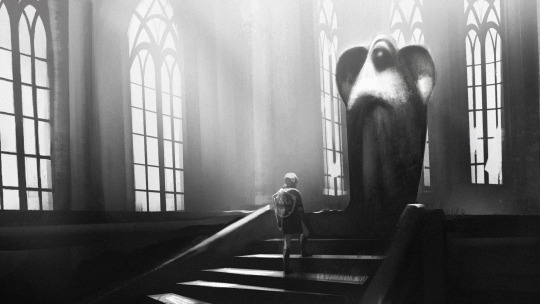
temple of time
#This is something I drew a couple of years ago but never finished because it just kept looking off#I decided to edit it now with my new knowledge of light and shadow#I like it a lot better now#although I can still see a few glaring issues with the architecture and perspective that I would have done differently#if I were to have drawn it now#but! cest la vie#it’s worth it to post considering I had initially worked on it for soooo long. so hopefully y’all like it#I wanted to originally have it in full color but that’s never going to happen lol#caroart#artists on tumblr#the legend of Zelda#loz#breath of the wild#botw#tears of the kingdom#totk#loz link#temple of time#loz fanart#illustration#Nintendo
315 notes
·
View notes
Text

#cuthbert beckett#beckett#vtmb#my art#fan art#I decided to take a break from Megumi and replay vtm r#my save is immediately at the temple of Set#people turning into snakes#I turn off the game to draw Beckett#yeah the guy with medium long black hair and sunglasses wonder what that reminds me of
877 notes
·
View notes
Text

June 8, 1897 Rilke and Andreas-Salomé: a love story in letters (1897-1926)
#rilke and andreas salome#rainer maria rilke#lou andreas salome#I’ve read many lines about love#but this one lit a candle in my ribs#rilke#june#june 8#lou salome#literature#words#quotes#academia#dark academia#quote#lit#books#books and libraries#love#reading#love language#i love you#quote of the day#bookworm#book quotes#prose#booklr#temples of longing#sanctum#fav
343 notes
·
View notes
Text
On Iris and Miles: the commonalities of Ace Attorney's most underrated duo
Ah, Iris and Miles...by this point it's no secret that the pair has one of my favorite dynamics in all of Ace Attorney. They're just...silly. Delightfully so. Autism-to-autism communication except their autism wavelengths aren't compatible in the slightest. Autism starers who hate being stared at lest the other see the hidden depths of their soul they’ve put so much work into hiding. Spacing out and getting lost in thought and needing to remind the other that they’re still there and the conversation isn’t over. Among many other charming little moments.




Of course, nothing in this series is surface level, and there's a lot more to be said about Iris and Miles aside from the fact they're both socially awkward disaster introverts who at times can barely seem to stumble their way through basic conversation (and believe me, I say that with nothing but love for them). In terms of fandom discussion, one of the most common things you'll see is conversations regarding Iris' canonical romantic feelings for Phoenix Wright versus Miles' subtextual ones (if it can even be called "subtext" at this point), and specifically how a certain bit of easily missable dialogue seems to imply that Iris is aware of Miles' feelings (which I give my thoughts on in this post here). And while analyzing their relationship from that angle can certainly be interesting...
There is so much more to Iris and Miles that I've never seen anyone else talk about.
Don't get me wrong; I don't think anyone's in the wrong for getting lost in Gay Lawyer Excitement. I'm far from innocent of it myself—it's compelling to think about, and the Narumitsu framework serves as a backdrop for much of my analysis on the franchise, BttT and Iris included. I just think it's reductive to focus solely on the possibility of love drama and jealousy between her and Miles, while ignoring everything else that makes that oft-referenced scene actually work—that being, the very way the two work exceptionally well together as characters, through the many, MANY parallels in their upbringing and traits that I can no longer be silent about.
In fact, I'm just gonna come out and say it: Sister Iris Fey-Hawthorne of Hazakura Temple mirrors Miles Edgeworth so goddamn much that she is quite literally the perfect choice for his first client as a defense attorney. And it's through this mirroring that his choice to defend her becomes so much more than a desire to help his childhood friend, or a chance to briefly live the life he once dreamed of at age nine—it's emblematic of his own personal self-acceptance and healing, and culminates his trilogy character arc in a beautifully full-circle, satisfying way. So, let's get into the details, shall we?
The first point I'd like to bring up is that Iris and Miles have a shared disdain of spirit channeling. There's some slight differences in how they express it—Iris' distaste is mostly directed toward the practice of channeling itself, as she states very early on in BttT. That said, she lives at Hazakura Temple even as an adult and continuously dedicates herself to her training, so she still has some level of respect (or at least tolerance) for spirit medium culture. Miles, on the other hand, rejects everything to do with channeling and mediums themselves/their lifestyle, as seen by how he angrily denounces Misty Fey at the mere mention of the Kurain Channeling Technique. The way his and Iris' lingering resentment presents itself is different, but the root of it is the same: The DL-6 Incident, an event that brought both of their families to ruin and left them with a great deal of trauma. They were inextricably linked by it years before they met—and though we never see Miles move beyond his denial of spiritual abilities (there's kinda a whole lotta other shit in BttT that needs to take priority), I like to think that he and Iris could have some very interesting conversations with each other on the subject post-canon.
Next, I'd like to point out that there's a noticeable parallel between Iris hiding herself away at Hazakura after Turnabout Memories and Miles “choosing death” after AA1. I'm of the opinion that neither of them had any intentions of returning to Phoenix, let alone explaining anything, when they set out to do so—Iris resolved to train endlessly as a form of self-flagellation penance, never appearing before Phoenix again so as not to hurt him any more, and Miles left his note at the Prosecutor’s Office with full confidence he would never again return to the courtroom (whether it was truly a suicide note is up for debate, but the game makes it fairly clear that before his offscreen epiphany Miles' initial choice was to leave his prosecutor career for good). They both wholly blamed themselves for being the reason they were even put in such a position, and their absences left Phoenix with unresolved grief as large as a mountain, and deep as an ocean. They both had events that brought them out of hiding—Miles chose to reforge his life and helped Phoenix from the shadows during Turnabout Big Top, and Iris received and accepted Godot’s request for help with his plan (though I’d imagine Phoenix’s presence caught her by complete surprise). They both were put through the wringer and came out of it resolving to reveal the truth. Phoenix, despite being hurt, wanted to believe in them both and ultimately decided to forgive them due to his unwavering faith.
Now, as for the events of BttT themselves, specifically Miles' choice to take up the mantle of a defense attorney and represent Iris in court, it's worth noting that he has multiple reasons for doing so. He just saw his best friend clam up in the hospital when pressed about Iris and wants to do what he can to help him heal, and in Miles' mind, truth in the most healing thing of all, so he becomes her attorney on the condition that she will eventually tell Phoenix what she's been hiding from him. The popular fanon joke about this is that Miles flew halfway across the world in a private jet when he heard his boyfriend was in peril, and took his attorney's badge simply because he couldn't say no to him—and they do have a point that that is an utterly Deranged™ way to express loyalty to someone...but I will argue until my dying breath that it wasn't just about Phoenix or Miles' latent feelings for him (or his latent jealousy prompting him to self-sabotage by pushing Feenris together). It was more than that.
Phoenix may have been the instigating factor, but I believe the reason Miles ultimately decided to defend Iris was because he empathized with her.
Because he saw himself in her.
A young, guarded individual stuck in the detention center for a murder they didn't commit. Going along with the punishment because even if the crime they're on trial for isn't the same as the one they committed, they believe themself guilty regardless. Stuck in a hopeless rut of neverending self-blame, and desperate to keep someone they care about from discovering the truth about them.
Sound familiar?




Miles doesn't make any promises to Iris initially, but after hearing her out...he learns of a tale all too familiar to his own experience in the defendant's seat two years prior, and he empathizes with it. He's far from upfront about his own feelings most of the time, but he demonstrates on multiple occasions that he actually has quite the knack for understanding other people's emotions (such as the end of BttT, when he explains to Phoenix that Maya is very emotionally resilient when there's someone she has to be strong for). Miles may have chosen the path of a prosecutor, but due to his upbringing of having been raised by Gregory, he has the instinct of a defense attorney—he feels strongly compelled to save people, whether they be the falsely accused or the victims of crime. And after finding common ground with Iris, he resolves to do the same thing for her as Phoenix once did for him—save her by proving her not guilty and giving her closure. It's an undeniably selfless act that speaks volumes as to how far he's come since we first met his douche-y AA1 self, and serves as excellent contrast for how we just saw Bratworth act in Turnabout Beginnings.
What really tips the scene over the edge, however...is that because Iris reminds Miles so much of himself, his offer to defend her becomes symbolic of his own self-acceptance.
While it's true he was proven innocent two years ago, and reinvented himself as the kind of prosecutor who can truly bring about justice for those who need it, and shows nothing but confidence in his newfound ideals...we never really see him acknowledge that he was worthy of such redemption. Certainly not with words, at least.
But thanks to Iris, we get to watch him prove it through his actions. Through his unyielding dedication to ensuring that this woman, who's clearly suffering from repressed guilt, knows that she is just as worthy as he was of being freed from her shackles, both real and self-imposed, by the all-encompassing light of truth. And I don't think it's a stretch to say that Iris found that inspiring. So much so that after a single conversation, she decides to finally let go of her need to obfuscate anything and everything about herself/her actions that could interfere with how she feels she has to be perceived in that moment, and begin to own up to the harm she's done by telling Miles what she did (in vague terms, granted, but this is the most progress ANYONE'S made in getting Iris to come forward with what’s on her mind to this point, which is still impressive). And for the first time, someone has helped her realize that maybe, just maybe...she could start on the path toward revealing the truth to the person most in need of the answers she's kept locked away in her heart all this time.
Iris wouldn't have found the courage to seek the truth if not for Miles. And it's because of Iris that Miles gets the chance to prove to himself that he was worthy of salvation all along.
They're perfect, your honor.
#ace attorney#phoenix wright ace attorney#ace attorney trials and tribulations#pwaa#aa#aa3#aa3 spoilers#bridge to the turnabout#miles edgeworth#iris hawthorne#iris fey#iris of hazakura temple#phoenix wright#narumitsu#feenris#mitsuyame#<-sorta...not written with ship-related intentions but if you wanna read it that way then by all means. go nuts#meta#my meta#OH BOY IT'S BEEN A LONG TIME COMING BUT FINALLY IT'S DONE. I CAN DIE HAPPY NOW#i love me some narumitsu but making miles' actions in 3-5 solely about phoenix really does a disservice to his compassion i feel#it's not always straightforward but he's better at it than most people give him credit for#i might've been lying when i say i do not respect miles edgeworth actually. i respect him for THIS and this alone#i'm insane i'm feral i'm rabid they're everything to me#local woman going feral over sister iris ace attorney for the 261478th time. more at 11
91 notes
·
View notes
Text

I just think the town politics ten years down the line would go crazy. we can talk about checks and balances or I can call you pompous and you can call me an idiot and we go from there

[open for quality holy god]
#okay. tags#notkin pathologic#khan kain#caspar kain#kaspar kain#pathologic#Мор Утопия#not pictured: capella just off screen rigorously massaging her temples#i think khan referred to a sisyphean task once and notkin was like ??? so he asked around for what that means and got wrong answers only#until danko was like Oh My Fuck stop gaslighting the semi-literate in this town and gave him the basics#i also think notkin went Huh. like doing the dishes#yeah man. like doing the dishes#anyway. the prospect of capella khan and notkin all having Some authority post-diurnal is so fascinating to me#capella at the top. but still#i have a great many thoughts. i am working on a fic. no one look at me#leo.draws#notkin's nose should be more fucked up but i'm tired of working on this#as long as string bean khan is clear we're good#they can mirror aspects of daniil and artemy. as a treat. cough#if i ever come back and render these. well i guess we'll see#enjoy your mid-effort sketches and tag rambles in the meantime
86 notes
·
View notes
Text



葫蘆寺
#葫蘆寺#士林區#taiwan#taipei#photography#architecture#streets#temple#lanterns#i took an extremely long roundabout walk on a quest for a familymart with a softserve machine#and happened upon this place in 社子
130 notes
·
View notes
Text
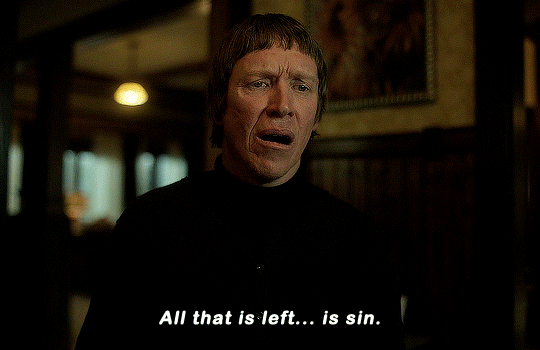




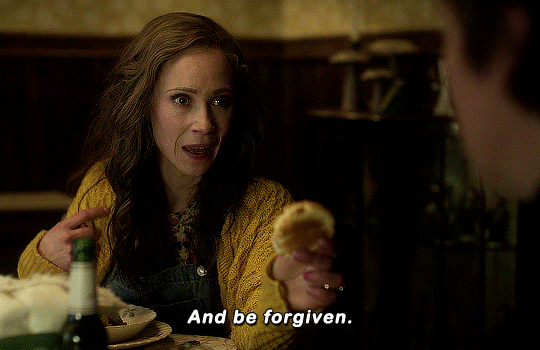
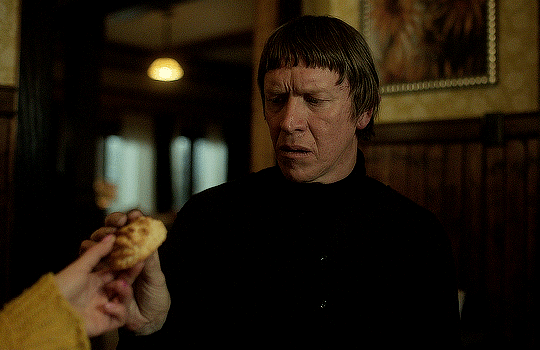



"The man lived on the moors and ate the fleas from the rats. He was frightened all the time. Then one day, a man comes on a wealthy horse and offers him two coins and a meal. But the food was not food. It was sin. The sins of the rich. Greed, envy, disgust. They were bitter-- the sins. But he ate them all, for he was starving. From then on, the man does not sleep or grow old. He cannot die. He has no dreams." FARGO FX - S5E10 - Bisquik
#fargoedit#fargo fx#fargo#ole munch#dorothy lyon#sam spruell#juno temple#television#gif#fargo spoilers#long post#food tw#the sins have been forgiven 😭
1K notes
·
View notes
Text
[Medicine]
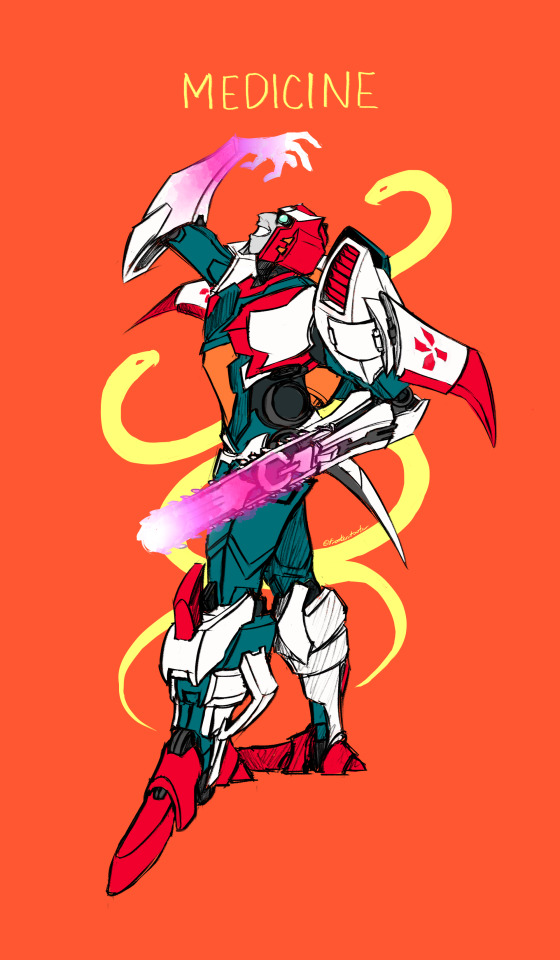
"The Caduceus. Commonly mixed up with the Rod of Asclepius."
Guys I think it'd be really funny if Pharma and Ratchet had the same voice
#he's got great shapes but I hate drawing his legs with a passion#Also the more I read into the cadueceus and rod of Asclepius#the more I go#“wait isn't that literally Ratchet and Pharma”#lost light spoilers in tags#I mean the Cadueceus being the wand of Hermes/ messengers of the gods *cough* and in some accounts having the ability to take and give life#While the Rod of Asclepius is held by the god Asclepius/god of healing and more accepted as the correct symbol for medicine/healing?#Also Asclepius being the son of Apollo -> the Temple of Apollo being located in Delphi Greece#The Cadueceus having wings -> Pharma has wings#Rod of Asclepius doesn't have wings -> Ratchet not having wings#The two symbols getting mixed up frequently -> Ratchet and Pharma looking pretty similar face/head-wise#Edit: another thing I just noticed: Two snakes on the Cadueceus -> Pharma and Adaptus fighting for control#someone must have made the connection before me right#James Roberts istg if this is intentional#I literally made the connection on accident after going “hey what if I added the snakes to this”#ok sorry for really long tags#mtmte spoilers#transformers#mtmte#maccadam#maccadams#tf idw#transformers fanart#frootertooter archive#more than meets the eye#pharma#pharma idw#lost light#LL
1K notes
·
View notes
Text
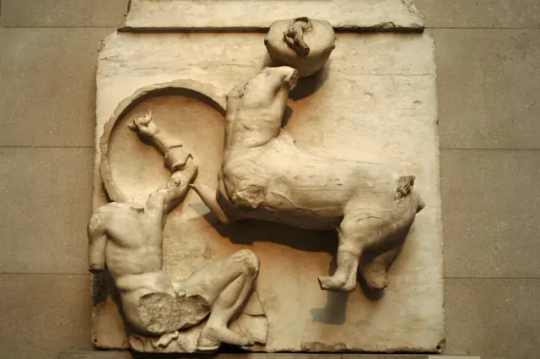
How This Parthenon Relief Was Torn Apart—Twice
South Metope IV is one of many sculptures from the ancient Greek temple whose fragments are scattered across the globe.
The Venetians struck the first blow. In 1687, amid the Great Turkish War, Venice’s forces rained a fusillade of cannonballs on the Ottoman-held Parthenon in Athens, Greece. The Turks had been using the Classical temple as a storage facility for their ammunition, believing it could withstand bombardment just as it had weathered history. Not so. The explosion demolished most of the Parthenon’s walls and columns, wrecking its architraves, triglyphs, and metopes.
After the blast, what remained of the Parthenon’s metopes, or relief-carved panels, were but shattered fragments. Some were picked up and reused as building material. Other parts were snatched by Western visitors eager for a piece of the temple. Thomas Bruce, Lord of Elgin, famously swung by to seize a trove of Parthenon marbles; Frenchman Louis-François-Sébastien Fauvel and Danish captain Moritz Hartmann, who was part of the Venetian fleet, also carried away their share of loot.
Amid this free-for-all, the metopes were scattered not just all over the Acropolis, but across the globe. Among them was South Metope IV, depicting a dramatic confrontation between a Centaur and a Lapith, that has been split apart for centuries.

19th-century engraving reconstructing the Parthenon in Athens at the time of Pericles.
When the Parthenon was completed in 432 B.C.E., it epitomized the height of Greek architecture—its colonnade, masonry, and magnificent frieze overseen by Phidias harmonizing in a grand tribute to the goddess Athena.
Spanning the temple’s entablature, the frieze held 92 metopes—28 facing the east and west, and 64 split evenly between the north and south sides. Each metope group, carved out of Pentellic marble, chronicles scenes from legendary clashes, often featuring two figures. The east, for example, retold the mythical clash between the Olympians and the Giants, while the north revisited the sack of Troy. The south side, meanwhile, detailed the fabled fight between the Lapiths, a Thessalian tribe, and the Centaurs who crashed the wedding feast of their king.
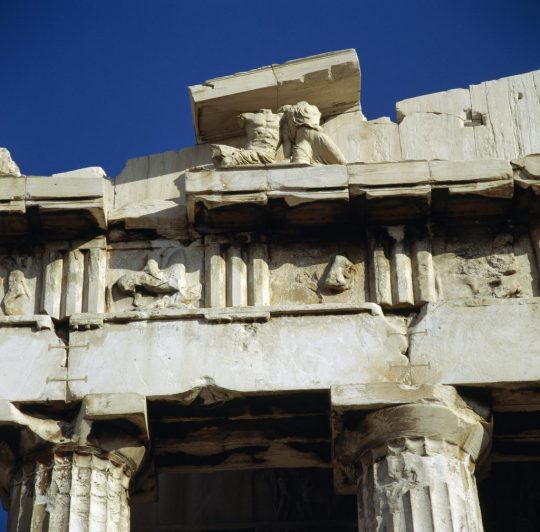
Metopes and reliefs on the west pediment of the Parthenon in Athens, Greece.
After facing calamities ranging from fire to vandalism by Christians, the metopes were finally toppled by the Venetians’ shells on September 26, 1687. In the early 19th century, South Metope IV joined some 14 others that wound up in the British Museum—but in a greatly reduced state. Where the panel once portrayed a Centaur raising a jug, ready to crash it onto a cowering Lapith vainly clutching a shield, the surviving artifact is missing both figures’ heads and part of their limbs.
The key to completing the metope, it turns out, rests in the collection of another institution: the National Museum of Denmark.
Back in 1687, army captain Hartmann snapped up the heads of a bearded man and a youth from a street vendor in Athens; he carried them home to Copenhagen where they ended up in the Royal Kunstkammer. Studies in the 1820s concluded that the heads were associated with South Metope IV. In the following decade, Denmark’s royal collection received yet another fragment linked to South Metope IV, this one shaped like a Centaur hoof.

Centaur head of South Metope IV from the Parthenon in Athens.
These heads add emotional heft to the metope. The bearded Centaur is carved with a steely gaze and his arm bent backward in preparation to strike; the young Lapith, in response, greets the incoming blow with a half-opened mouth and wide eyes. (The former relic is also covered in a mysterious brown stain that has long confounded scientists.)
And there are yet more parts to the metope. While the Danish Museum holds one of the Centaur’s hoofs, the figure’s left hind leg is all the way back in Athens, in the Acropolis Museum. South Metope IV, therefore, is “literally and metaphorically torn between London, Copenhagen, and Athens,” as George Vardas, secretary of the Australian Hellenic Council, wrote in Greek City Times—and it is not the only Parthenon sculpture to be so divided.
We have from the same figure, half of the body in Athens, half of the body in London,” said Dimitrios Pandermalis, the director of the Acropolis Museum, in 2009. “We have a body in London and a head in Athens. We have horses in London, and the tails of the horses are in Athens. It is a moral problem in art of divided monuments.”

Lapith head of South Metope IV from the Parthenon in Athens.
In 2015, the British Museum and the National Museum of Denmark collaborated on a digital reconstruction of South Metope IV, imagining how the work once appeared, complete with polychromy. But the day that the museums’ respective pieces might be physically reunited appears far off.
Both the Copenhagen and British institutions have spurned Greece’s continued appeals for the return of the Parthenon marbles. In 2023, the Danish museum’s director Rane Willerslev noted that its fragments “are of greater importance to the National Museum than if they were sent to Greece.” The U.K.’s drawn-out talks with Greece regarding the Parthenon relics, meanwhile, remain “ongoing,” according to the British Museum in 2024.

The Parthenon Gallery in the Acropolis Museum in Athens, Greece.
Perhaps the best place to see a form of the somewhat complete metope is in the Acropolis Museum, which houses a plaster cast of the South Metope IV. Installed in its Parthenon gallery, the replica affixes the figures’ heads to their bodies, leaving out their lost limbs but painting no less of an intense encounter. The museum’s aim is to eventually reunite the original elements of the Parthenon compositions. With South Metope IV, a left hind leg represents a first step.
By Min Chen.
#The Parthenon#How This Parthenon Relief Was Torn Apart—Twice#Athens Greece#marble#marble sculptures#ancient greek temple#ancient artifacts#archeology#history#history news#ancient history#ancient culture#ancient civilizations#ancient greece#greek history#greek art#ancient art#long post#long reads
85 notes
·
View notes